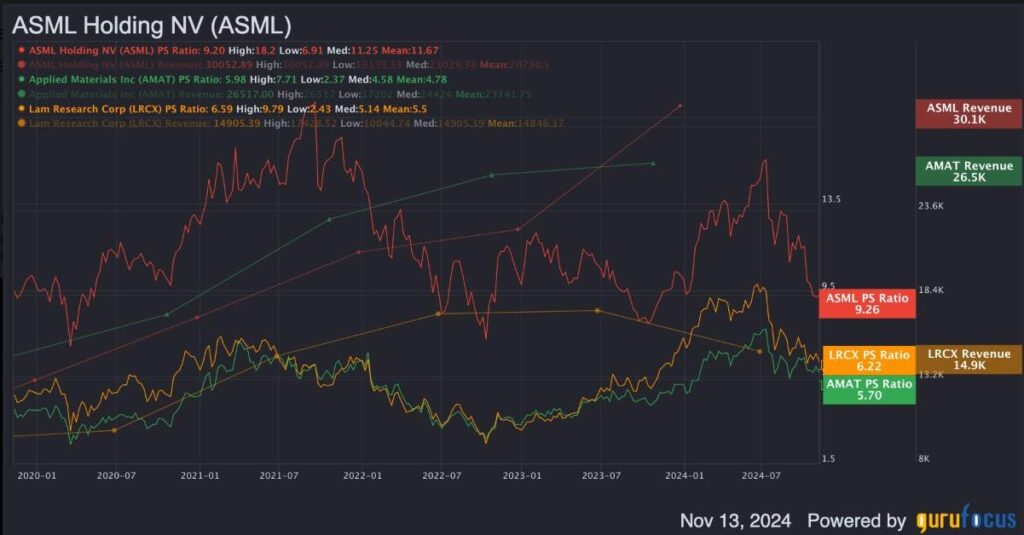ASML, a leading semiconductor manufacturing equipment supplier, has recently faced a decline in stock value due to a less favorable demand forecast for 2025. The company, which holds a monopoly on advanced lithography systems critical to semiconductor fabrication, saw its stock drop following management’s revision of revenue expectations. Initially projected to see substantial growth in 2025, the forecast has now shifted, predicting revenues between $30 billion and $35 billion—much lower than earlier estimates. Despite this downward adjustment causing market reaction, analysis suggests that ASML’s stock may be undervalued in the current climate, which presents a potential investment opportunity with a predicted 20% increase in enterprise value over the next year.
In its Q3 report, ASML revealed a normalized earnings per share (EPS) growth of 15.66% year-over-year, with total revenues amounting to $8.13 billion. However, the announcement of a weaker outlook for 2025 concerning lithography demand highlighted potential cyclicality risks that might be tied to the gradual expansion of AI data centers. The demand delay for extreme ultraviolet (EUV) systems, ASML’s primary product, can be partly attributed to major clients like Samsung and Intel experiencing issues related to securing customers and capitalizing on production capacities amidst uncertain market conditions. Furthermore, geopolitical tensions, particularly involving China, pose additional challenges for ASML’s operations, impacting its ability to fulfill contracts with certain foundries.
Despite a significant decline in its share price—approximately 22.5% since the latest earnings report—ASML currently trades at a forward price-to-earnings ratio that is lower than the firm’s historical norms. While the stock’s valuation appears justified given its weaker growth outlook, it still indicates potential for recovery. Analyst projections suggest that ASML may reach upper revenue targets, with a possible EV-to-sales ratio increase projected. Such analysis, driven by projected growth rates and market sentiment, suggests that now could be a suitable moment to consider ASML for a short-term investment approach, especially relative to competitors like Applied Materials and Lam Research.
The semiconductor sector is inherently cyclical, prompting investors to be cautious in viewing ASML as a long-term holding without addressing volatility. Strategic timing became crucial, where investing at the beginning of an upcycle and divesting as growth peaks provides a more prudent strategy within this market. Nonetheless, ASML commands a strong position in the industry, uniquely benefiting from long-term trends in artificial intelligence (AI) and semiconductor demands as the market shifts its focus. Although there will inevitably be fluctuations following the peak in AI infrastructure building, monitoring ASML’s performance leading into 2025 could offer attractive investment opportunities for discerning investors.
A detailed discounted EBITDA analysis over the next six years reveals promising growth for ASML, especially with projected revenues reflecting an average year-over-year growth of 12.5% annually. It presents a solid base for assessing intrinsic value, taking into consideration conservative estimates of profitability margins. By utilizing a terminal multiple based on historical EV-to-EBITDA ratios, insights point towards robust potential for earnings expansion within the company, supporting a strong investment thesis moving forward into the semiconductor landscape’s future.
Nonetheless, ASML faces external risks, including emerging competition focused on establishing self-sufficiency in semiconductor production, particularly in China. Although it successfully maintains a competitive moat, vigilance is necessary given the current geopolitical climate that poses threats to market stability and international relations. The potential for escalated trade tensions presents a layer of risk that investors must navigate. However, it is believed that the current political landscape may sustain economic engagements, promoting favorable conditions for ASML’s continued prosperity in the semiconductor sector, thereby supporting an investment decision.
In conclusion, ASML’s market position signals upcoming growth even amidst a volatile outlook for 2025. While its valuation presents compelling opportunities for near-term and medium-term investors, maintaining flexibility in investment strategy is vital as the sector experiences cyclical fluctuations. With careful monitoring, capital allocation in ASML allows for exposure to anticipated growth, notwithstanding the potential hurdles from competition and geopolitical instability. The analysis finds ASML to remain a valuable investment choice at this juncture, poised to capture growth in the evolving technological landscape despite challenges in the semiconductor market.

